“Support.Microsoft.com Says” pop-up is a misleading advertising that created in order to trick you into calling fake Microsoft support service. If you are seeing these “Support.Microsoft.com Says” pop-ups in the Edge, Internet Explorer, Firefox and Google Chrome every time you use the web-browser to surf the Internet, then it is possible that you accidentally installed potentially unwanted application (PUA) from the adware (also known as ‘ad-supported’ software) category on your personal computer. The adware looks the entire traffic generated by you and on this basis, it displays tons of unwanted ads. Currently, this adware are widely spread, due to the fact that most people are trying to find free applications, download and install them on the PC system without proper attention to the fact that the adware can be installed onto the machine along with them.

Adware that designed to display misleading “Support.Microsoft.com Says” pop-up warnings within your web browser can add lots of ads directly to the web-sites that you visit, creating a sense that the advertising links have been added by the makers of the web page. Moreover, a legal advertising banners may be replaced on the fake ads, that will offer to download and install various unnecessary and harmful software.
The worst is, the adware has the ability to collect lots of confidential info about you (your ip address, what is a page you are viewing now, what you are looking for on the Internet, which links you are clicking), which can later transfer to third parties.
Therefore it is very important to follow the few simple steps below as quickly as possible. The guidance will help you to delete adware as well as clean your computer from the “Support.Microsoft.com Says” popup. What is more, the tutorial below will allow you delete other harmful programs such as undesired toolbars and browser hijackers, which can be installed onto PC along with the ‘ad supported’ software.
Remove “Support.Microsoft.com Says” pop-up warnings
In the few simple steps below, we will try to cover the Edge, Microsoft Internet Explorer, Google Chrome and Firefox and provide general help to remove “Support.Microsoft.com Says” pop up scam. You may find some minor differences in your Windows install. No matter, you should be okay if you follow the steps outlined below: uninstall all suspicious and unknown applications, reset browsers settings, fix browsers shortcuts, delete malicious scheduled tasks, run free malicious software removal utilities. Some of the steps will require you to reboot your computer or exit this website. So, read this tutorial carefully, then bookmark or print it for later reference.
To remove “Support.Microsoft.com Says”, execute the steps below:
- How to manually remove “Support.Microsoft.com Says”
- Run free malware removal utilities to completely remove “Support.Microsoft.com Says” pop-up
- Stop “Support.Microsoft.com Says” pop-up scam and other undesired pages
- How to “Support.Microsoft.com Says” pop up scam get installed onto machine
- Finish words
How to manually remove “Support.Microsoft.com Says”
The step-by-step instructions will help you get rid of “Support.Microsoft.com Says” pop-up. These “Support.Microsoft.com Says” removal steps work for the Microsoft Edge, IE, Google Chrome and Mozilla Firefox, as well as every version of MS Windows operating system.
Delete ad-supported software through the Windows Control Panel
Some potentially unwanted programs, browser hijacking software and adware may be deleted by uninstalling the free applications they came with. If this way does not succeed, then looking them up in the list of installed applications in Microsoft Windows Control Panel. Use the “Uninstall” command in order to remove them.
Windows 8, 8.1, 10
First, click the Windows button
Windows XP, Vista, 7
First, click “Start” and select “Control Panel”.
It will open the Windows Control Panel as on the image below.
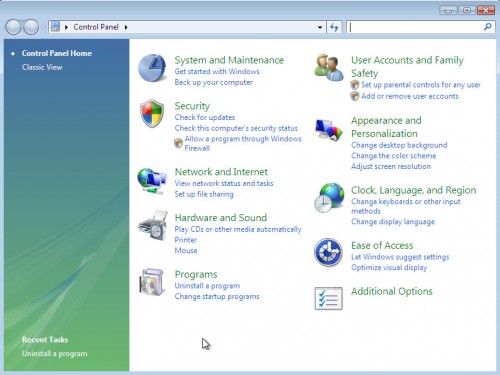
Next, press “Uninstall a program” ![]()
It will open a list of all applications installed on your machine. Scroll through the all list, and remove any suspicious and unknown programs. To quickly find the latest installed apps, we recommend sort applications by date in the Control panel.
Remove “Support.Microsoft.com Says” popup from Google Chrome
Reset Google Chrome settings is a easy way to remove the adware, malicious and adware extensions, as well as to restore the web-browser’s default search provider, newtab and startpage that have been modified by adware that causes misleading “Support.Microsoft.com Says” popup scam on your internet browser.
First open the Google Chrome. Next, click the button in the form of three horizontal dots (![]() ).
).
It will display the Chrome menu. Choose More Tools, then press Extensions. Carefully browse through the list of installed add-ons. If the list has the extension signed with “Installed by enterprise policy” or “Installed by your administrator”, then complete the following tutorial: Remove Google Chrome extensions installed by enterprise policy.
Open the Google Chrome menu once again. Further, click the option called “Settings”.

The web browser will show the settings screen. Another solution to open the Chrome’s settings – type chrome://settings in the web-browser adress bar and press Enter
Scroll down to the bottom of the page and click the “Advanced” link. Now scroll down until the “Reset” section is visible, as shown in the following example and click the “Reset settings to their original defaults” button.

The Chrome will display the confirmation dialog box as displayed in the following example.

You need to confirm your action, press the “Reset” button. The browser will run the task of cleaning. Once it is complete, the web-browser’s settings including default search provider, newtab page and home page back to the values which have been when the Google Chrome was first installed on your system.
Get rid of “Support.Microsoft.com Says” fake alerts from Mozilla Firefox
If the Mozilla Firefox web-browser program is hijacked, then resetting its settings can help. The Reset feature is available on all modern version of Firefox. A reset can fix many issues by restoring Firefox settings like default search engine, start page and newtab to their default values. It’ll keep your personal information like browsing history, bookmarks, passwords and web form auto-fill data.
Press the Menu button (looks like three horizontal lines), and click the blue Help icon located at the bottom of the drop down menu as shown on the image below.
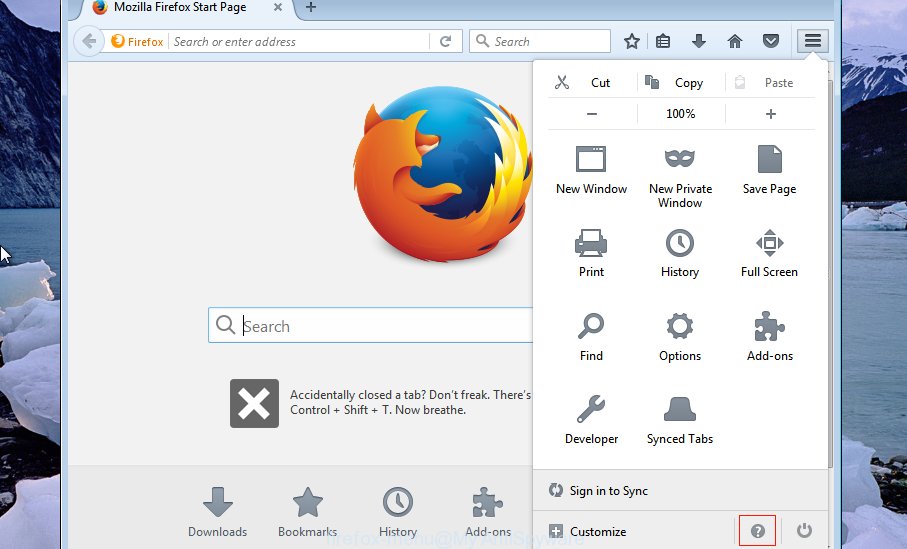
A small menu will appear, click the “Troubleshooting Information”. On this page, press “Refresh Firefox” button as shown on the screen below.

Follow the onscreen procedure to return your Mozilla Firefox web browser settings to their default values.
Get rid of “Support.Microsoft.com Says” fake alerts from Internet Explorer
In order to restore all internet browser newtab, search engine and start page you need to reset the Microsoft Internet Explorer to the state, that was when the Windows was installed on your computer.
First, open the IE. Next, click the button in the form of gear (![]() ). It will show the Tools drop-down menu, press the “Internet Options” as shown in the following example.
). It will show the Tools drop-down menu, press the “Internet Options” as shown in the following example.

In the “Internet Options” window click on the Advanced tab, then click the Reset button. The Internet Explorer will display the “Reset Internet Explorer settings” window as shown on the screen below. Select the “Delete personal settings” check box, then click “Reset” button.

You will now need to restart your system for the changes to take effect.
Run free malware removal utilities to completely remove “Support.Microsoft.com Says” pop-up
If your system is still infected with adware which displays misleading “Support.Microsoft.com Says” pop up warnings on your personal computer, then the best method of detection and removal is to run an anti-malware scan on the machine. Download free malware removal tools below and start a full system scan. It will help you delete all components of the ad supported software from hardisk and Windows registry.
Scan and clean your web browser of “Support.Microsoft.com Says” pop-up warnings with Zemana Anti-malware
We recommend you to run the Zemana Anti-malware that are completely clean your system of adware that causes multiple misleading “Support.Microsoft.com Says” alerts and pop-ups. Moreover, the tool will help you to remove potentially unwanted software, malware, toolbars and browser hijackers that your PC can be infected too.

- Click the following link to download the latest version of Zemana for Windows. Save it to your Desktop.
Zemana AntiMalware
165503 downloads
Author: Zemana Ltd
Category: Security tools
Update: July 16, 2019
- At the download page, click on the Download button. Your internet browser will show the “Save as” prompt. Please save it onto your Windows desktop.
- When the download is complete, please close all applications and open windows on your personal computer. Next, start a file named Zemana.AntiMalware.Setup.
- This will open the “Setup wizard” of Zemana AntiMalware (ZAM) onto your PC. Follow the prompts and don’t make any changes to default settings.
- When the Setup wizard has finished installing, the Zemana will open and open the main window.
- Further, press the “Scan” button for checking your personal computer for the ‘ad supported’ software that displays misleading “Support.Microsoft.com Says” fake alerts on your computer. Depending on your PC, the scan can take anywhere from a few minutes to close to an hour. During the scan Zemana Free will detect threats present on your personal computer.
- When the checking is finished, Zemana AntiMalware will display a scan report.
- Review the scan results and then press the “Next” button. The tool will get rid of adware that cause misleading “Support.Microsoft.com Says” fake alerts to appear and add threats to the Quarantine. When disinfection is finished, you may be prompted to restart the computer.
- Close the Zemana Anti Malware and continue with the next step.
Run Hitman Pro to get rid of “Support.Microsoft.com Says” pop-up from browser
Hitman Pro is a portable program which requires no hard installation to detect and get rid of adware which causes misleading “Support.Microsoft.com Says” popup scam on your web-browser. The program itself is small in size (only a few Mb). Hitman Pro does not need any drivers and special dlls. It is probably easier to use than any alternative malicious software removal tools you have ever tried. Hitman Pro works on 64 and 32-bit versions of Windows 10, 8, 7 and XP. It proves that removal utility can be just as effective as the widely known antivirus programs.
Visit the following page to download HitmanPro. Save it on your Microsoft Windows desktop.
Download and use HitmanPro on your computer. Once started, click “Next” button to perform a system scan with this tool for the adware which designed to display misleading “Support.Microsoft.com Says” pop up warnings within your web browser. This procedure can take some time, so please be patient. While the utility is checking, you can see how many objects and files has already scanned..
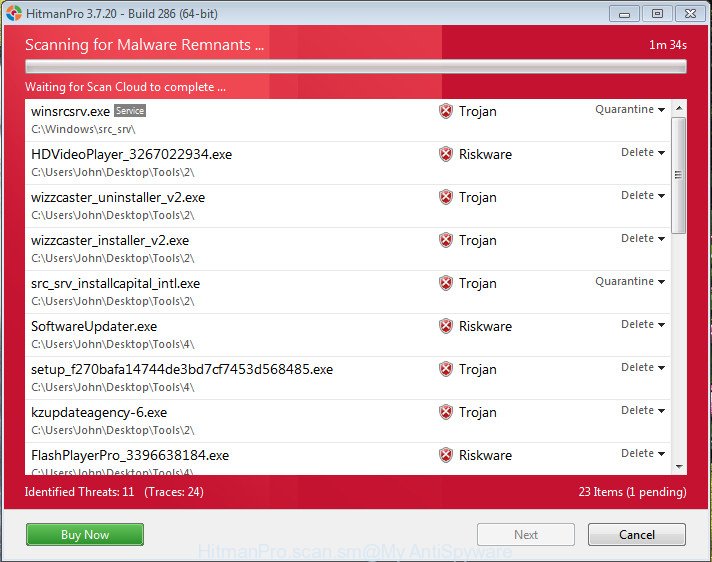
When Hitman Pro has completed scanning, the results are displayed in the scan report.
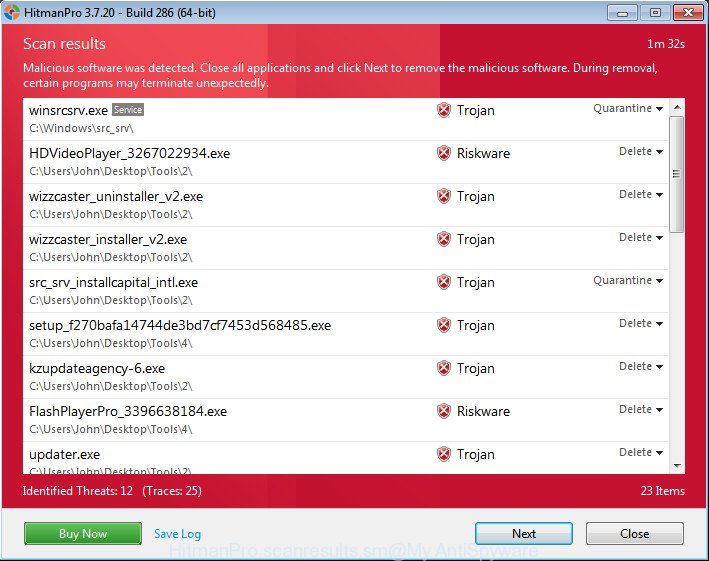
Make sure all threats have ‘checkmark’ and click Next button.
It will open a prompt, press the “Activate free license” button to begin the free 30 days trial to delete all malware found.
Scan and clean your machine of adware with Malwarebytes
We advise using the Malwarebytes Free. You can download and install Malwarebytes to scan for adware and thereby get rid of “Support.Microsoft.com Says” pop up from your browsers. When installed and updated, the free malicious software remover will automatically scan and detect all threats exist on the machine.
Visit the following page to download MalwareBytes Anti-Malware (MBAM). Save it to your Desktop so that you can access the file easily.
327724 downloads
Author: Malwarebytes
Category: Security tools
Update: April 15, 2020
After downloading is finished, close all software and windows on your personal computer. Double-click the set up file called mb3-setup. If the “User Account Control” dialog box pops up as shown in the following example, click the “Yes” button.

It will open the “Setup wizard” which will help you install MalwareBytes AntiMalware on your computer. Follow the prompts and do not make any changes to default settings.
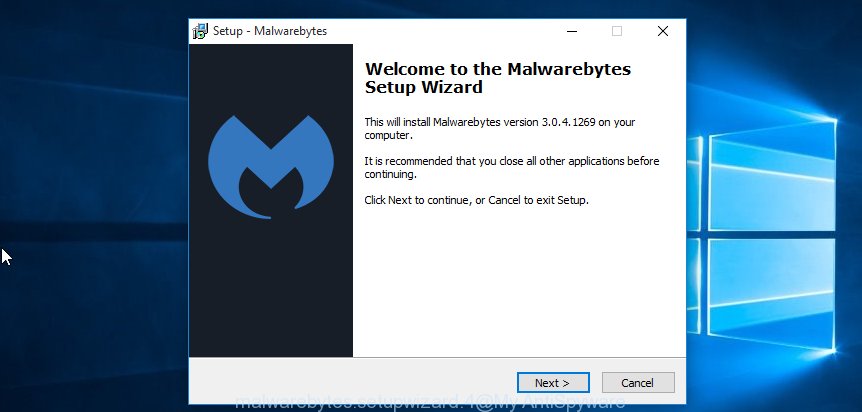
Once installation is complete successfully, click Finish button. MalwareBytes Free will automatically start and you can see its main screen as shown in the figure below.
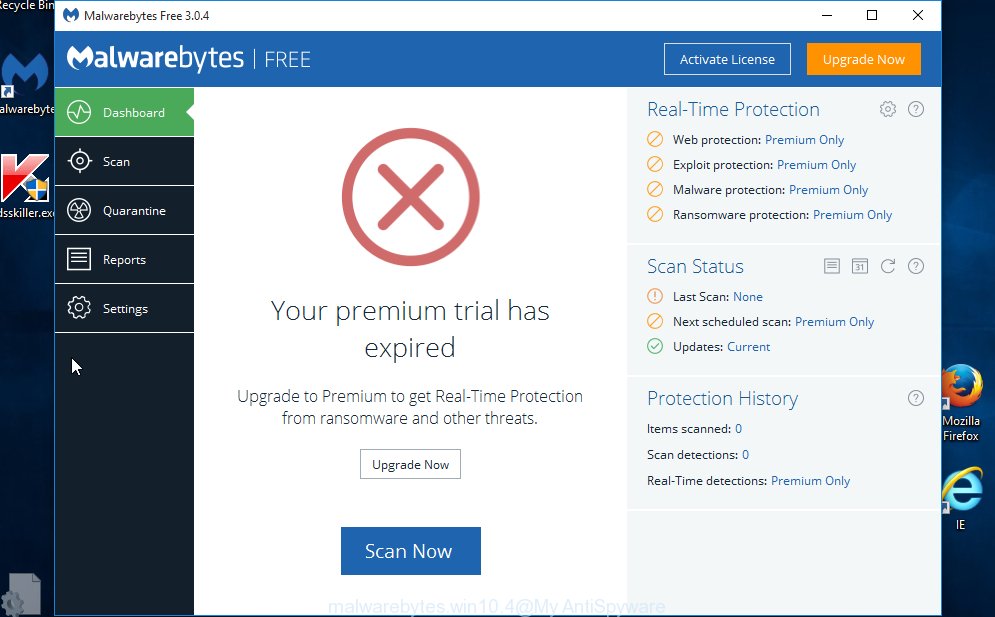
Now click the “Scan Now” button to look for adware that designed to show misleading “Support.Microsoft.com Says” popup within your browser. Depending on your PC system, the scan can take anywhere from a few minutes to close to an hour. When a threat is detected, the count of the security threats will change accordingly. Wait until the the checking is finished.
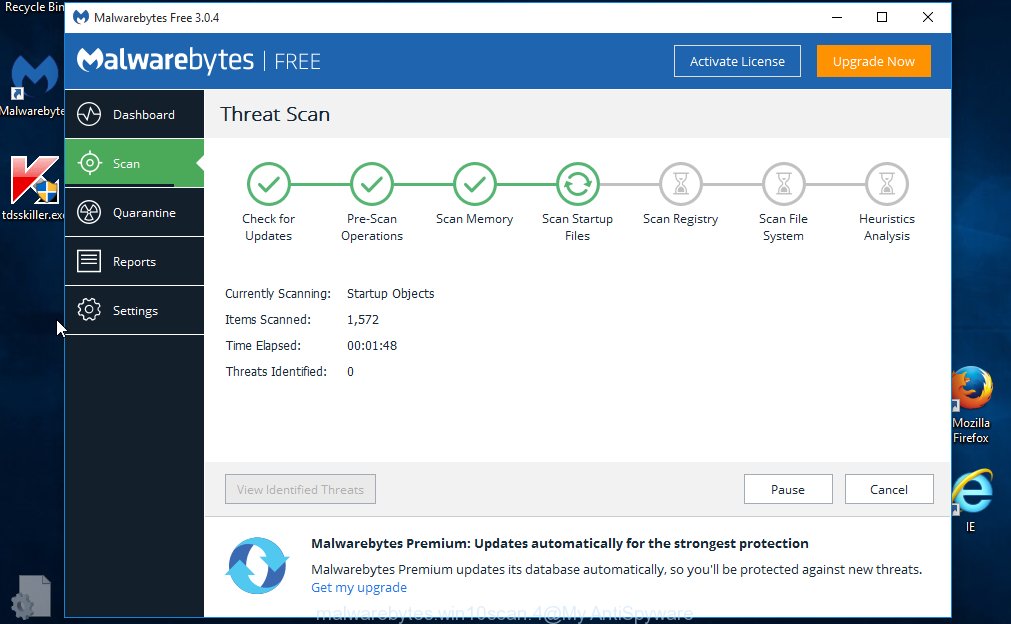
When MalwareBytes AntiMalware has finished scanning your system, MalwareBytes Anti Malware (MBAM) will show a scan report. Make sure all threats have ‘checkmark’ and click “Quarantine Selected” button. The MalwareBytes Anti Malware (MBAM) will get rid of adware which causes misleading “Support.Microsoft.com Says” fake alerts on your browser. When the clean up is complete, you may be prompted to reboot the PC.

We recommend you look at the following video, which completely explains the procedure of using the MalwareBytes Free to get rid of adware, browser hijacker and other malware.
Stop “Support.Microsoft.com Says” pop-up scam and other undesired pages
To put it simply, you need to use an ad blocking tool (AdGuard, for example). It’ll block and protect you from all unwanted pages such as “Support.Microsoft.com Says”, ads and popups. To be able to do that, the ad blocking program uses a list of filters. Each filter is a rule that describes a malicious web-page, an advertising content, a banner and others. The ad-blocker application automatically uses these filters, depending on the webpages you are visiting.
Download AdGuard on your Microsoft Windows Desktop by clicking on the following link.
27036 downloads
Version: 6.4
Author: © Adguard
Category: Security tools
Update: November 15, 2018
After downloading it, double-click the downloaded file to run it. The “Setup Wizard” window will show up on the computer screen as displayed on the image below.

Follow the prompts. AdGuard will then be installed and an icon will be placed on your desktop. A window will show up asking you to confirm that you want to see a quick guide as displayed on the image below.

Press “Skip” button to close the window and use the default settings, or click “Get Started” to see an quick instructions that will help you get to know AdGuard better.
Each time, when you start your machine, AdGuard will launch automatically and block popups, “Support.Microsoft.com Says” redirect, as well as other harmful or misleading web sites. For an overview of all the features of the program, or to change its settings you can simply double-click on the AdGuard icon, which can be found on your desktop.
How to “Support.Microsoft.com Says” pop up scam get installed onto machine
The adware usually spreads together with another program in the same installer. The risk of this is especially high for the various free applications downloaded from the Web. The developers of the apps are hoping that users will run the quick installation mode, that is simply to click the Next button, without paying attention to the information on the screen and don’t carefully considering every step of the installation procedure. Thus, the ad supported software can infiltrate your computer without your knowledge. Therefore, it’s very important to read all the information that tells the application during setup, including the ‘Terms of Use’ and ‘Software license’. Use only the Manual, Custom or Advanced install option. This mode will allow you to disable all optional and unwanted applications and components.
Finish words
Now your machine should be clean of the adware that causes misleading “Support.Microsoft.com Says” popup warnings on your internet browser. We suggest that you keep AdGuard (to help you block unwanted pop up ads and annoying harmful web-sites) and Zemana Anti Malware (ZAM) (to periodically scan your computer for new adwares and other malicious software). Probably you are running an older version of Java or Adobe Flash Player. This can be a security risk, so download and install the latest version right now.
If you are still having problems while trying to remove “Support.Microsoft.com Says” fake alerts from the Edge, Google Chrome, Mozilla Firefox and Microsoft Internet Explorer, then ask for help here here.


















